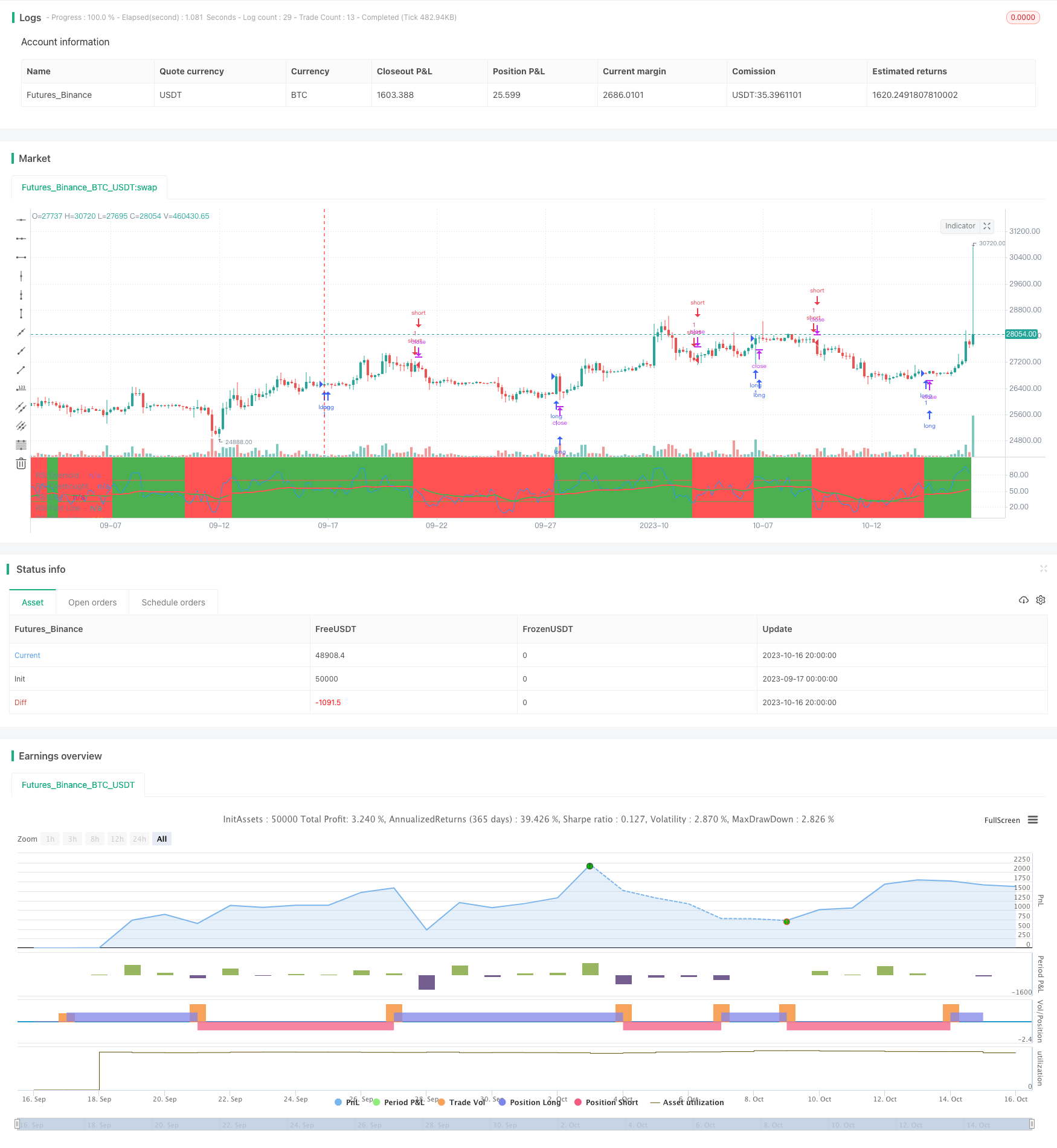
概述
RSI金叉死叉策略利用RSI指标的快线和慢线的金叉和死叉来确定买入和卖出的时机。当快线上穿慢线时为金叉,表示 strain过卖,应当买入。当快线下穿慢线时为死叉,表示 strain过买,应当卖出。该策略结合RSI指标的超买超卖判断,可以有效避免虚假信号。
策略原理
该策略首先计算RSI指标,设置RSI参数为5周期。然后设置快线EMA为RSI的20周期均线,慢线EMA为RSI的50周期均线。当快线上穿慢线时生成买入信号,当快线下穿慢线时生成卖出信号。同时设置RSI超买线为70,超卖线为30,这可以过滤掉一些虚假信号。
策略原理主要基于以下几点:
RSI指标可以判断是否进入超买或者超卖状态。RSI高于70为超买区,低于30为超卖区。
快线EMA反应更迅速,可以判断 strain的短期趋势改变。慢线EMA更平稳,可以判断 strain中长期趋势。
当快线上穿慢线时,表示 strain从超卖向上反转,属于买入信号。
当快线下穿慢线时,表示 strain从超买向下反转,属于卖出信号。
设置超买超卖线,可以过滤一些多头市场中的卖出信号,和空头市场中的买入信号。
整体来说,该策略结合RSI指标的优势,使用双EMA判断金叉和死叉,可以捕捉市场的短期和中期转折点,实现对趋势的判断。
策略优势
RSI金叉死叉策略具有以下几点优势:
使用RSI指标判断超买超卖状态,可以有效避免追高杀跌。
快慢EMA结合判断金叉死叉,兼顾了操作的灵敏度和稳定性。
超买超卖阈值设置过滤了部分噪音交易信号。
策略思路简单清晰,容易理解实现,适合量化交易开发。
可在不同市场环境中灵活应用,回测效果较佳。
可通过调整RSI周期、快慢EMA周期等参数进行优化,适应市场变化。
策略风险可控,避免单方面追涨杀跌的风险。
策略风险
RSI金叉死叉策略也存在一定的风险,主要包括:
RSI指标发出错误信号的风险,RSI依然可能出现背离。
双EMA判断产生错误信号的风险,存在一定的滞后。
超买超卖阈值设置不当,可能过滤掉较好的交易机会。
在震荡盘整市场中,金叉死叉信号频繁,带来高额的交易成本和滑点风险。
参数设置(如RSI周期,EMA周期等)不合理,可能错过交易机会或增加虚假信号。
需要积累充足的历史数据才能形成交易信号,数据不足时效果较差。
无法判断 market 趋势,在 market 反转时会产生亏损。
对应风险需要注意参数优化,合理止损,避免过度交易,积累足够数据等。
策略优化方向
RSI金叉死叉策略可以从以下几个方面进行优化:
优化RSI参数,测试不同的RSI周期参数,使其更符合 market 的特点。
优化快慢EMA周期参数,使其能够捕捉更多交易机会。
测试不同的超买超卖阈值,防止错过较大行情。
结合其它指标判断 market 趋势,避免反转带来的亏损。
设定合理的止损策略,控制单次亏损。
设定交易量管理策略,防止单次亏损过大。
在开仓后考虑部分止盈 exiting,锁定部分利润。
考虑在趋势较强时进行重仓操作,在震荡 market 中减少交易。
测试不同市场及参数下的策略稳定性,进行多市场验证。
通过参数和风险管理等多方面的综合优化,可以大幅提高RSI金叉死叉策略的稳定性和profitability。
总结
RSI金叉死叉策略整体来说是一种较为常见的量化策略思路。它结合RSI指标的优势,使用双EMA产生交易信号,可以有效判断市场的短期中期转折点。该策略优化空间大、风险可控,可以通过调整参数适应不同市场环境,具有良好的通用性。但也需要注意防止产生过多错误信号,并做好风险控制。如果参数设置得当,回测效果较佳,可以成为一个易于实现的量化交易策略选择。
/*backtest
start: 2023-09-17 00:00:00
end: 2023-10-17 00:00:00
period: 4h
basePeriod: 15m
exchanges: [{"eid":"Futures_Binance","currency":"BTC_USDT"}]
*/
// This source code is subject to the terms of the Mozilla Public License 2.0 at https://mozilla.org/MPL/2.0/
// © xaurr
//@version=4
strategy("RSI Cross [xaurr]", shorttitle="RSIC",overlay=false)
src = input(title="Source", type=input.source, defval=close)
//RSI Strategy
period = input(5,"RSI Period", minval=1)
overSold = input(30,"RSI Oversold", minval=1)
overBought = input(70, "RSI Overbought", minval=1)
fastPeriod = input(20,"Smooth Fast Period")
slowPeriod = input(50,"Smooth Slow Period")
rsi = rsi(src, period)
fast = ema(rsi,fastPeriod)
slow = ema(rsi,slowPeriod)
long = crossover(fast,slow)
short = crossunder(fast,slow)
pos = 0
pos:= long ?1:short ?-1 : nz(pos[1])
plot(overSold,"RSI Oversold",color=color.green)
plot(overBought, "RSI Overbought",color=color.red)
plot(rsi, linewidth = 1, color = color.blue, title="RSI Line")
plot(fast, linewidth = 2, color = color.green, title="RSI Fast Line")
plot(slow, linewidth = 2, color = color.red, title="RSI Slow Line")
bgcolor(pos == 1 ? color.green : pos == -1 ? color.red : na)
if pos == 1
strategy.entry("long",strategy.long)
if pos == -1
strategy.entry("short",strategy.short)